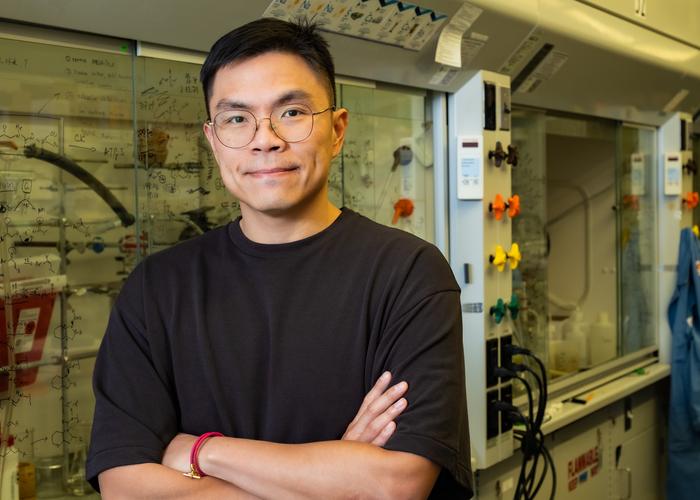In a groundbreaking study that promises to revolutionize the field of synthetic organic chemistry, a research team led by Rice University scientists has unveiled a novel enzyme-driven strategy capable of transforming a single terpenoid scaffold into a rich diversity of complex molecular architectures. This innovative methodology blends the power of engineered enzymes with sophisticated chemical transformations to unlock a universe of molecular possibilities, shattering long-held doctrines that dictated a one-to-one relationship between natural product scaffolds and bespoke synthetic routes.
For decades, the chemical synthesis of natural products, particularly terpenoids—one of the largest and most structurally diverse classes of natural compounds—has been an intricate puzzle for chemists. Conventional wisdom held that each terpenoid skeleton, owing to its distinctive arrangement of carbon atoms and stereochemistry, necessitated a unique synthetic blueprint. This presumption rendered synthetic campaigns labor-intensive and time-consuming, as chemists were often forced to laboriously design de novo syntheses for each new target.
Challenging this paradigm, Hans Renata, associate professor of chemistry at Rice University, spearheaded a transformative study published recently in Nature Chemistry. His team developed a strategy that centers on the enzymatic oxidation of a single widely available terpenoid precursor, sclareolide, which is traditionally recognized for its applications in the fragrance industry. The researchers harnessed cytochrome enzymes—biological catalysts known for their unparalleled selectivity and capacity to mediate formidable oxidation reactions—to regioselectively functionalize sclareolide’s C3 position, a feat unattainable by standard synthetic methods.
This selective enzymatic oxidation generates a pivotal alcohol intermediate that dramatically expands the chemical scaffold’s synthetic utility. Rather than being constrained to conventional interpretations of biosynthetic pathways, the team cleverly integrated nonbiological chemical transformations following enzymatic oxidation to create what is termed ‘abiotic scaffold hopping.’ This approach facilitates the remodeling of molecular frameworks in unprecedented ways, enabling the rapid generation of structurally diverse terpenoids from a common enzymatic intermediate.
Through this method, the research group synthesized four distinct terpenoid natural products: merosterolic acid B, cochlioquinone B, (+)-daucene, and dolasta-1(15),8-diene. Each of these molecules possesses unique carbon frameworks originating from the oxidized sclareolide scaffold, demonstrating the method’s potency in streamlining the synthesis of diverse natural products. Importantly, this convergent strategy circumvents the need for designing entirely new synthetic routes for chemically related, yet structurally distinct, terpenoids.
The implications of this research extend far beyond methodological innovation. By rewriting the rules of retrosynthesis—traditionally a retrosynthetic analysis involves deconstructing a target molecule into simpler precursor structures with a view to laying out efficient synthetic pathways—Renata and his colleagues advocate a more holistic and flexible blueprint. Their enzymatic oxidation step acts as a shared molecular entry point, from which multiple pathways can diverge, enabling the generation of multiple targets in fewer synthetic operations.
From a mechanistic perspective, the engineered cytochrome enzymes employed in this study exhibit remarkable selectivity and regio-control, performing oxidation on a typically inert carbon atom in sclareolide. Cytochromes, with their heme prosthetic groups, carry out redox reactions pivotal in nature’s metabolic toolkit. By tuning their specificity through protein engineering, the researchers expanded the enzyme’s reactivity profile to accommodate novel substrates and transform them into versatile synthetic handles.
The strategic fusion of enzymatic catalysis with subsequent chemical reactions underscores the potential of biocatalysis in modern synthetic chemistry. Historically, enzymatic transformations were generally perceived as either endpoints or simple modifications of complex molecules. Here, however, the enzymatic step serves as a nexus—an enabling platform that unlocks new synthetic routes uncharted by traditional chemistry.
Beyond mere academic curiosity, this approach holds promise for medicinal chemistry and drug discovery. Terpenoids are a treasure trove of bioactive compounds with diverse pharmacological profiles, yet their chemical complexity often impedes their scalable synthesis. By affording streamlined access to a multitude of terpenoid frameworks from a common precursor, this scaffold hopping paradigm can accelerate the development and diversification of natural product-inspired therapeutics.
Economically and practically, the ability to generate multiple molecules from a single precursor significantly reduces the cumulative labor, time, and material costs associated with traditional natural product synthesis. This efficiency gain could have ripple effects, enabling more sustainable and green chemistry practices by minimizing wasteful multi-step syntheses and reliance on scarce starting materials.
Renata emphasized the conceptual shift brought forth by their work: “Our research illustrates how a single enzymatic oxidation can serve as a molecular hub, expanding the chemical space accessible to synthetic chemists. It’s a strategy that transcends the limitations of scaffold-focused thinking and opens new frontiers in molecular design and synthesis.” This comment captures the transformative potential of integrating biocatalysis into synthetic retrosynthesis.
The study was enriched by the contributions of Rice graduate student Junhong Yang, former postdoctoral researcher Heping Deng, Fuzhuo Li from Fudan University, and Jian Li of Shanghai Jiao Tong University. It also received essential financial support from the U.S. National Science Foundation and the Alfred P. Sloan Foundation, underscoring the importance of collaborative and funded interdisciplinary research in pushing the boundaries of chemistry.
As the chemical sciences continue to seek innovative solutions to complex synthetic challenges, this enzyme-enabled abiotic scaffold hopping approach illuminates a path that leverages the exquisite specificity of biology and the versatility of chemical synthesis. It reflects a broader trend where the convergence of these disciplines can accelerate the exploration of chemical diversity and facilitate the discovery of novel compounds with potentially transformative applications.
This integration of enzymatic and chemical methods exemplifies how the future of synthesis is poised to become more efficient, flexible, and imaginative. By rethinking classical retrosynthetic approaches and embracing enzyme engineering, chemists may soon routinely access vast regions of chemical space that were once deemed inaccessible or impractical.
Subject of Research: Enzyme-enabled synthetic methodology for diverse terpenoid frameworks
Article Title: Synthesis of diverse terpenoid frameworks via enzyme-enabled abiotic scaffold hop
News Publication Date: 16-Jun-2025
Web References: https://www.nature.com/articles/s41557-025-01852-6
References: Renata et al., Nature Chemistry, June 16, 2025; DOI: 10.1038/s41557-025-01852-6
Image Credits: Photo by Jeff Fitlow/Rice University
Keywords
Enzymes, Oxidation, Molecular chemistry, Chemical processes, Biochemical processes, Biosynthetic pathways




